In which of the following examples of motion can the body be considered a particle?
(i) A monkey sitting on the shoulders of a man who is cycling
(ii) A tumbling beaker that has slipped off the edge of a table.
(iii) A cricket ball thrown by a bowler to a batsman 20 m away.
To determine in which of the given examples of motion a body can be considered a particle, we need to analyze each scenario based on the principles of motion and the factors that affect it.
1. Understanding the Concept of a Particle:
- A body can be considered a particle if its size and shape do not significantly affect its motion. This typically applies to objects where the effects of forces like air resistance or friction are negligible.
2. Analyzing the First Example:
- A monkey sitting on the shoulders of a man who is cycling:
- In this case, the motion of the monkey is closely tied to the motion of the man. The monkey is not moving independently, and its size does not significantly affect the overall motion of the man and the bicycle. Therefore, we can consider the monkey as a particle in this scenario.
3. Analyzing the Second Example:
- A tumbling beaker that has slipped off the edge of a table:
- The tumbling motion of the beaker is affected by its shape, size, and the forces acting on it (like gravity and air resistance). Because these factors significantly influence its motion, the beaker cannot be considered a particle.
4. Analyzing the Third Example:
- A cricket ball thrown by a bowler to a batsman 20 m away:
- The cricket ball is subject to various forces such as air resistance and gravity. These forces affect its trajectory and motion. Hence, the cricket ball cannot be treated as a particle in this context.
5. Conclusion:
- Based on the analysis, the only example where the body can be considered a particle is the first one: A monkey sitting on the shoulders of a man who is cycling.
Final Answer:
The body can be considered a particle in the case of (i) A monkey sitting on the shoulders of a man who is cycling.
- A body can be considered a particle if its size and shape do not significantly affect its motion. This typically applies to objects where the effects of forces like air resistance or friction are negligible.
- A monkey sitting on the shoulders of a man who is cycling:
- In this case, the motion of the monkey is closely tied to the motion of the man. The monkey is not moving independently, and its size does not significantly affect the overall motion of the man and the bicycle. Therefore, we can consider the monkey as a particle in this scenario.
- A tumbling beaker that has slipped off the edge of a table:
- The tumbling motion of the beaker is affected by its shape, size, and the forces acting on it (like gravity and air resistance). Because these factors significantly influence its motion, the beaker cannot be considered a particle.
- A cricket ball thrown by a bowler to a batsman 20 m away:
- The cricket ball is subject to various forces such as air resistance and gravity. These forces affect its trajectory and motion. Hence, the cricket ball cannot be treated as a particle in this context.
- Based on the analysis, the only example where the body can be considered a particle is the first one: A monkey sitting on the shoulders of a man who is cycling.
The body can be considered a particle in the case of (i) A monkey sitting on the shoulders of a man who is cycling.
Topper's Solved these Questions
- DESCRIPTION OF MOTIONBook:CENGAGE PHYSICSChapter:DESCRIPTION OF MOTIONExercise:MANDATORY EXERCISE (EXERCISE SET - II)
Explore 7 Videos
- DESCRIPTION OF MOTIONBook:CENGAGE PHYSICSChapter:DESCRIPTION OF MOTIONExercise:MANDATORY EXERCISE (EXERCISE SET - III)
Explore 12 Videos
- DESCRIPTION OF MOTIONBook:CENGAGE PHYSICSChapter:DESCRIPTION OF MOTIONExercise:OLYMPIAD AND NTSE LEVEL EXERCISE
Explore 10 Videos
- ELASTICITYBook:CENGAGE PHYSICSChapter:ELASTICITYExercise:OLYMPIAD AND NTSE LEVEL EXERCISES
Explore 10 Videos
Similar Questions
In which of the following exmples of motion, can the body be considered approxinmately a point object :
(a) a railway carriage moving without jerks between two two stations.
(b) a mondey sistting on top of a man cycling smoothly on a circulat track. (c ) a spinning cricket ball that turns sharply on hitting the round . (d) a tumbling beake theat has slopped off the edge of a table ?
View SolutionThe DNA content of individual cells and the number of cells in each phase of a cell cycle" can be determined using flow cytometry. Which of the following combinations of "phase of a cell cycle and its corresponding DNA content" can be considered normal?
(i) Diploid cells found in the G0 or G1 phase.
(ii) Cells with twice the normal DNA content in the early M phase.
(iii) Cells with twice the normal DNA content in the G2 phase.
View Solution
Knowledge Check
The general motion of a rigid body can be considered to be a combination of (i) a motion of its centre of mass about an axis, and (ii) its motion about an instantaneous exis passing through the centre of mass. These axes need not be stationary. Consider, for example, a thin uniform disc welded (rigidly fixed) horizontally at its rim to a massless, stick as shown in the figure. When the disc-stick system is rotated about the origin on a horizontal frictionless plane with angular speed ω the motion at any instant can be taken as a combination of (i) a rotation of the disc through an instantaneous vertical axis passing through its centre of mass (as is seen from the changed orientation of points P and Q). Both these motions have the same angular speed ω in this case

Now consider two similar system as shown in the figure: Case (a) the disc with its face vertical and parallel to x-z plane, Case (b) the disc with its face making an angle of 45∘ with x-y plane and its horizontal diameter parallel to x-axis. In both the cases, the disc is welded at point P, and the systems are rotated with constant angular speed ω about the z-axis.
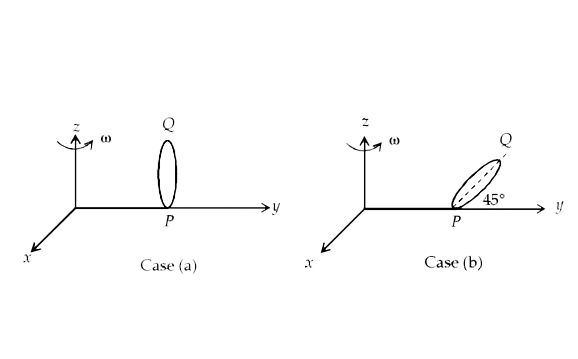
Which of the following statements regarding the angular speed about the instantaneous axis (passing through the centre of mass) is correct?Ait is √2ω for both the casesBit is ω for cases (a), and ω/√2 for case (b)Cit is ω for case (a), and √2ω for case (b)Dit is ω for both the cases.Which of the following statements are true ?
(i) A uniform wooden plank of mass 150kg and length 8m is floating on still water with a man of 50kg at one end of it. The man walks to the other end of the plank and stops. The distance covered by the plank is 2m.
(ii) A kid of mass 15kg is sitting in a boat of mass 45kg in a lake. The distance of kid from the bank of lake is 12m. Now the body moves inside the boat at a distance 4m towards the bank and stops. The distance of the kid from the bank (there is no friction between the water and the boat ) is 11m.
(iii) Two persons of masses 40kg and 60kg are sitting at the midpoint of a 12−m- long boat (140kg) standing still in water. Now they move to opposite ends of the boat. Neglecting the friction between boat and water, the distance traveled by the boat in water is 50cm.
(iv) In a gravity free space , a man of mass m standing at a height h above the floor, throws a ball of mass m0 straight down with a speed v0. When the ball reaches the floor, the distance of the man above the floor is (1+m0m)h.A(i),(ii)B(i) ,(iii) ,(iv)C(ii),(iii),(iv)Dall of the aboveFor a particle moving along a straight line consider following graphs A, B, C and D. Here x, v and t are position, velocity and time respectively.
(i) In which of the graphs the magnitude of acceleration is decreasing with time?
(ii) In which of the graphs the magnitude of acceleration is increasing with time?
(iii) If the body is definitely going away from the starting point with time, which of the given graphs represent this condition.A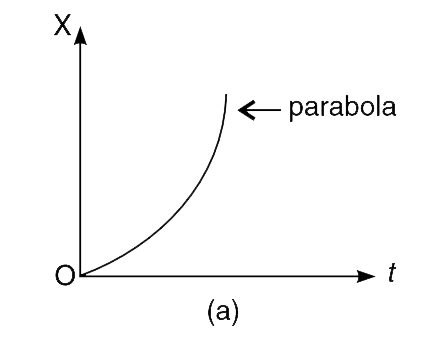 B
B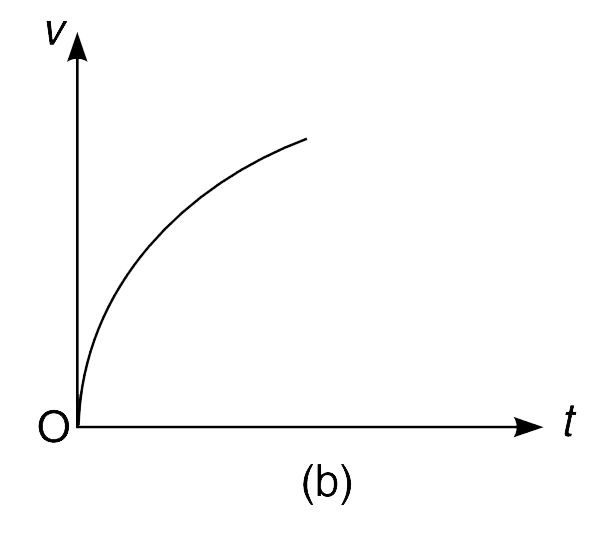 C
C D
D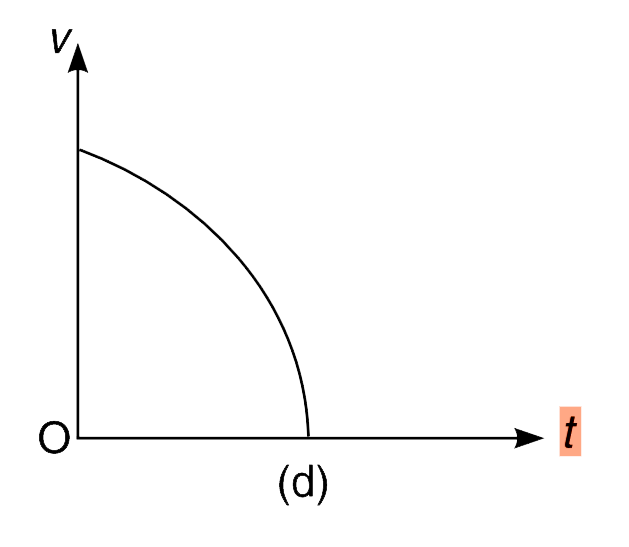
Whenever a body is thrown vertically upwards with a certain velocity, the upwards motion is opposed by gravitational pull of earth and resisatnce of air. The velocity of the body goes on decreasing at a constant rate (=−g).As soon as upward velocity of body becomes zero, it cannot rise any more. The height it has attained is the maximum height. The body then begins to fall downwards with an acceleration =g.
Read the above passege and answer the following questions :
(i) A body is thrown upwards with a velocity of 19.6m/s. What is the maximum height attained?
(ii) With what velocity will the body hit the ground?
(iii) What are the implications of this study in day to day life ?
View Solution(i) A small steel ball (B) is at rest on the edge of a table of height h. Another identical steel ball (A) is tied to a light string of length L =1.0 m and is released from the position shown so that it swings like a pendulum. At the lowest position of its path it hits the ball B which is at rest. Ball B flies off the table and hits the ground in time t. After collision the ball A keeps moving for a time t before coming to rest for the first time. Find the value of h if t = t. Collision between the balls is head on and coefficient of restitution is e = 0.995.
(ii) A pendulum has a particle of mass m attached to a massless rod of length L. The rod is released from a position where it makes an angle θ0(>π2) with the vertical. The time period of oscillation is observed to be T0. Another similar pendulum has a rod of length 2L. Time period of this pendulum when released from position θ0 is T. Which is larger T or T0 ?
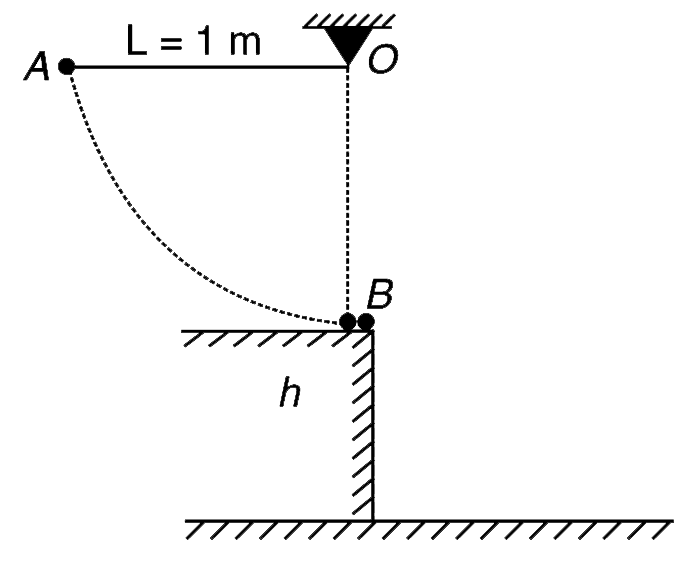
View SolutionA ball is thrown straight up from the edge of the roof of a building .A second ball is dropped from the roof 1.00s later. You may ignore air resistance.
a. If the height of the buliding is 20.0m, what must the initial speed be of the first ball if both are to hit the ground at the same time? Consider the same situation, but now let the initial speed v0 of the first ball be given and treat the height (h) of the building as an unknown.
b. What must the height of the building be for both balls to reach the ground at the same time for each of the following values of v0: (i) 6.0ms−1 (ii) 9.5ms−1?
c. If v0 is greater than some values vmax, a value of (h) does same time. Solve for vmax. The value vmin also has a simple physical interpretation. What is it?
View SolutionRead the following passage and answer the item that follow.
PASSAGE-II
On a surface which is free from obstacles, such as a clear road or a path, only two or three species of snakes can hope to catch up with a human being, even if they are foolish to try. A snake seems to move very fast but its movements are deceptive. In spite of the swift, wave-like motions of its body, the snake crawls along the ground at no more than the speed of man's walk. It may, however, have an advantage inside a jungle, where the progress of a man is obstructed by thorny bushes. But in such places, the footsteps of a man are usually more than enough to warn snakes to keep away. Although they have no ears of the usual kind, they can feel slight vibrations of the ground through their bodies, and thus get an early warning of danger.
The snake has an advantage over men inside a jungle, because there :
View SolutionA student performs an experiment to determine how the range of a ball depends on the velocity with which it is projected. The "range" is the distance between the points where the ball lends and from where it was projected, assuming it lands at the same height from which it was projected. It each trial, the student uses the same baseball, and launches it at the same angle. Table shows the experimental results.
∣∣ ∣ ∣ ∣ ∣ ∣∣TrailLaunch speed(m/s)Range(m)110822031.833070.7440122.5∣∣ ∣ ∣ ∣ ∣ ∣∣
Based on this data, the student then hypothesizes that the range, R, depends on the initial speed v0 according to the following equation : R=Cvn0, where C is a constant and n is another constant.
The student speculates that the constant C depends on :-
(i) The angle at which the ball was launched (ii) The ball's mass (iii) The ball's diameter
If we neglect air resistance, then C actually depends on :-
View Solution
